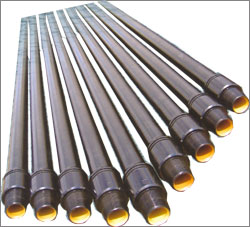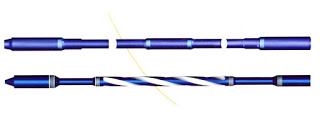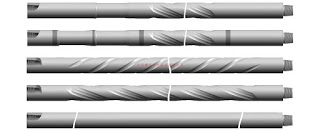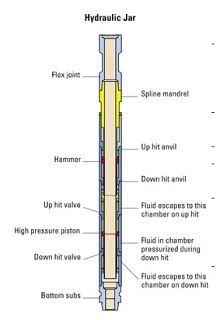Drill String
The drillstring means the tubulars and the accessories used to run the drill bit to the bottom. The drill string is composed of drill pipe, heavy weight drill pipe, drill collars and other components like stabilizers and drilling jars.
There are many functions of the drill string among them:
- Suspend the drill bit
- Transmit the rotary motion from the Kelly or top drive to the drill bit
- Provide a flow path to circulate drilling fluids
The bottom hole assembly BHA is the components used above the bit without taking in consideration the drill pipe.
Drill pipe :
 The drill pipe constitutes the majority of the drill string length. It is seamless with threaded connections. The drill pipe has two tool joints, one female is called a box and the other male is called pin. The outer diameter of the tool joint is larger than the body of the drill pipe to accommodate the threads.
The drill pipe constitutes the majority of the drill string length. It is seamless with threaded connections. The drill pipe has two tool joints, one female is called a box and the other male is called pin. The outer diameter of the tool joint is larger than the body of the drill pipe to accommodate the threads.One drill pipe is called a single or a joint. The dimensions of the drill pipe are specified by the API (American petroleum Institute). There are three ranges of length; range 2 is most common on rig sites. The drill pipe must be measured on rig site to get accurate length of drill pipe. The drill pipe is manufactured in verity of weight, diameters and also materiel grades. The specification of drill pipe can appear as: (5'' 19.lb/ft Grade S Range2).
The drill pipe is characterized by burst, collapse, tensile and torsional strength. These specifications are used to select the appropriate drill pipe for a particular drilling operation.
The weight of the drill pipe mentioned in the manual is called weight in air. When drill pipe is in the well, it has to be taken in consideration the buoyancy force which is related to density of the drilling fluid. The weight of the drill pipe when run in the well can be calculated as follows:
Buoyant weight= weight of pipe in air x buoyancy factor
Drill pipe stress and failure:
The drill pipe can be exposed to many stresses:
- Tension: due to hole problems, an overpull can be exerted causing extra tension on the drill pipe (ex: stuck pipe). This tensile load can lead to drill pipe failing.
- Torsion: Bad hole conditions can increase the twisting force and torque on each joint leading to poor rotation transmission from the surface to the bottom.
- Cyclic fatigue: The wall of the drill pipe while drilling deviated wells is exposed at point of bending to tensile and compressive forces. While rotating the drill string, the same point on a drill pipe sustains a cycle tensile and compressive forces. This cyclic stresses can result in fatigue of the drill pipe.
Also there are other causes of fatigue like abrasive friction, vibration and bit bouncing off bottom.
Corrosion is also another issue which can affect drill pipe strength; corrosion can be due to presence of dissolved gases and acids. Carbone dioxide can form acid dioxide which can lead to steel corrosion.
The hydrogen sulfide can be present in the formation. It can cause hydrogen embrittlement or sulfide stress cracking. The surface of the steel absorbs the hydrogen in the presence of the sulfide. When the concentration will be greater than a certain level(less than 13 ppm), cracks can appear on pipe body. The combinations of stress and cracks leads to pipe failure.
Tool joints:
 The tool joints provide screw threads in order to connect drill pipes together. The seal is guaranteed by the shoulder/shoulder connections between pin and box. Hard facing material is welded on the surface to protect the tool joint from abrasive wear when rotating drill string in the borehole or when making connection by rig tongs. This layer of hard facing material can be replaced in workshops when it becomes depleted due to excessive wear. The internal diameter of the tool joint is less than the internal diameter of main body. The same stresses applied on the drill pipe during drilling operations are subjected on the tool joint, but also there are other additional issues:
The tool joints provide screw threads in order to connect drill pipes together. The seal is guaranteed by the shoulder/shoulder connections between pin and box. Hard facing material is welded on the surface to protect the tool joint from abrasive wear when rotating drill string in the borehole or when making connection by rig tongs. This layer of hard facing material can be replaced in workshops when it becomes depleted due to excessive wear. The internal diameter of the tool joint is less than the internal diameter of main body. The same stresses applied on the drill pipe during drilling operations are subjected on the tool joint, but also there are other additional issues:- During operations, frequent engagement of box and pins can be done harshly which can damage the threads.
- When tripping out of the hole, the last tool joint support all the weight of the string beneath it.
Heavy weight drill pipe (HWDP) :
 Heavy weight drill pipe has a greater wall thickness if we compare it with the wall thickness of ordinary drill pipe. It is used instead of drill pipe where the stresses concentration is important. These stresses are due to:
Heavy weight drill pipe has a greater wall thickness if we compare it with the wall thickness of ordinary drill pipe. It is used instead of drill pipe where the stresses concentration is important. These stresses are due to:- The sharp difference in cross section between the drill pipe and drill collars.
- The difference in stiffness between the drill pipe and drill collars
- The bouncing caused by the bit while drilling
The main benefit of using the HWDP is absorbing the stresses being transferred from the drill collars to the drill pipe. The use of HWDP between drill collars and drill pipe can minimize the stresses caused by the high level of difference in stiffness.
The heavy weight drill pipe is characterized by many features:
- High wall thickness
- Long tool joint
- More hard facing
For operations, the heavy weight drill pipe should be operated in compression; in order to maintain the compression while drilling highly deviated wells.
Drill collars:
 Drill collars have larger outer diameter and smaller inner diameter than drill pipe. The functions of drill collars are:
Drill collars have larger outer diameter and smaller inner diameter than drill pipe. The functions of drill collars are:- Provide the required weight on bit while drilling
- Maintain drill string in tension which reduces bending and fatigue failures.
- Provide stiffness for directional control
The connection thread of a drill collar can be machined directly on the body due to the large wall thickness. In order to prevent failure, correct make up torque has to be applied. It is very important to handle drill collars carefully. Shoulders and threads should be lubricated with lubricant containing 40% to 60% of metallic-zinc powder.
Similarly to drill pipe, drill collars are subjected to different stresses caused by:
- Bending and buckling forces
- Tension
- Vibration
- Alternate tension and compression
There are other types of drill collars used for special operations:
- Spiral drill collars are used to avoid stuck while drilling through highly porous formation. The stuck can occur when high overbalanced of mud pressure is applied or while drilling high deviated wells. Among the methods used to minimize the risk of differential sticking is reducing the contact area between the collars and wellbore. In order to reduce the surface contact, spiral grooves are cut on collars.
- Nonmagnetic collars: this type of collars is used to isolate survey instruments from magnetic distortion caused by the steel of the drill string. The magnetic distortion can affect the directional instrument functioning.
Other drill string components:
Stabilizers :
 Stabilizers are piece of pipe with blades machined on the external surface. The blades can be spiral or straight, normally they are 3 blades. They have many functions
Stabilizers are piece of pipe with blades machined on the external surface. The blades can be spiral or straight, normally they are 3 blades. They have many functions- Reducing bending and buckling stresses on drill collars
- Remaining the string in concentric position which allows higher WOB.
- Preventing stuck by differential sticking.
During operations, stabilizers can wear and become under-gauge. If the stabilizers become 3/16" under-gauge, they have to be replaced to operate effectively.
Shock sub:
 A shock sub is used to dampen the vibration caused by the bit while drilling hard formation. it is normally located above the drilling bit to minimize stresses due to bit bouncing. The shock sub absorbs the vertical vibrations using a steel spring. Reducing bit bouncing has many advantages:
A shock sub is used to dampen the vibration caused by the bit while drilling hard formation. it is normally located above the drilling bit to minimize stresses due to bit bouncing. The shock sub absorbs the vertical vibrations using a steel spring. Reducing bit bouncing has many advantages:- Extending bit life by reducing impact on teeth
- Avoid string failures
- Reduce damage to surface equipment
Subs:
They are short joints of pipe used as crossovers. The main function is adapting the threads, the size, or both of them to connect different joints of string components.
Drilling jars
 It is a very important piece of equipment which has to be used in any drill string. It is used to free the
It is a very important piece of equipment which has to be used in any drill string. It is used to free the string if any stuck pipe is faced. They are activated by a straight pull and provide an upward blow. The sharp motion or blow can shake the string and free it. The drilling jar is placed above the drill collars and it is not recommended to work in compression.



